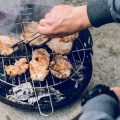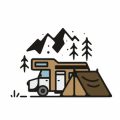1. Understand Your Camping Style
Before you book your first campsite, its important to understand the different types of camping available. Each style offers a unique experience and comes with its own set of comforts and challenges. Figuring out what kind of camping suits your personality and trip goals will help make your first outing a success.
Types of Camping
Let’s break down the most common styles of camping so you can find the one that best fits your comfort level and outdoor expectations.
| Camping Type | Description | Best For |
|---|---|---|
| Car Camping | You park your car at or near your campsite. Great for beginners since you can bring more gear and amenities. | First-timers, families, casual weekend trips |
| Tent Camping | You hike or walk into a designated site and set up a tent. Offers a more traditional outdoor feel without being too extreme. | Nature lovers, people looking for a quiet escape |
| RV Camping | You camp in a recreational vehicle with access to electricity, plumbing, and shelter. Often found in developed campgrounds with hookups. | Campers who want comfort, families, road trippers |
| Backcountry Camping | You hike into remote areas carrying all your gear. No amenities—just nature. Requires planning and survival skills. | Experienced hikers, adventure seekers |
Picking What Works for You
If youre new to camping, car camping is usually the easiest way to get started. It allows you to test out your gear and get comfortable with sleeping outside without being too far from help or amenities. Tent camping gives you a bit more immersion in nature but still keeps things manageable if you choose an established campground. RV camping is ideal if you like the idea of bringing some home comforts with you on the road. And if youre already experienced with hiking and want total solitude, backcountry camping could be your goal—but probably not for your first trip.
A Few Questions to Ask Yourself:
- How much gear do I have? If youre starting from scratch, car or RV camping lets you build up slowly.
- Do I want access to restrooms or showers? Many campgrounds for car and RV camping offer these amenities.
- Am I ready to disconnect completely? Backcountry sites may have no cell service or facilities.
- How far am I willing to travel? Some campsites are remote and require hiking or driving long distances.
The key is choosing a style that aligns with how adventurous (or relaxed) you want your first trip to be. Don’t worry—you can always explore other types later as you gain experience!
2. Choose the Right Location
Picking the right campsite starts with choosing the right location. In the U.S., there are several types of campgrounds to consider, each offering different experiences, amenities, and vibes. Whether youre looking for peaceful nature or fun activities, understanding your options will help you find the perfect spot for your first outdoor adventure.
Types of Campgrounds
Here’s a quick look at the most common types of campgrounds in the U.S.:
| Campground Type | Description | Best For |
|---|---|---|
| National Parks | Operated by the National Park Service, these offer stunning natural scenery and are often located near iconic landmarks like Yellowstone or Yosemite. | Nature lovers, hikers, photographers |
| State Parks | Run by individual states, they provide a mix of natural beauty and family-friendly facilities. Often less crowded than national parks. | Families, weekend campers, beginners |
| Private Campgrounds | Privately owned and often more developed with amenities like Wi-Fi, showers, laundry rooms, and even pools or playgrounds. | Comfort seekers, RV travelers, first-timers |
What to Consider When Choosing a Location
🌄 Scenery & Environment
Do you want to wake up next to a lake or be surrounded by mountains? Think about what kind of natural setting you’d enjoy most. National and state parks usually offer more breathtaking views, while private sites may be more accessible but less scenic.
🚿 Amenities
If it’s your first time camping, you might prefer a place with restrooms, running water, picnic tables, and maybe even electricity. Private campgrounds usually have more of these creature comforts compared to public ones.
🏞️ Nearby Activities
Are you into hiking, fishing, swimming, or just relaxing by the fire? Check what’s available nearby before booking. National and state parks often feature trails and lakes; private campgrounds may offer organized activities or rentals.
Quick Tips for First-Timers
- Book early: Popular spots fill up fast—especially during summer weekends.
- Check reviews: Websites like Recreation.gov or Campendium offer real camper feedback.
- Stay close to home: For your first trip, pick a campground within a few hours’ drive in case you forget something or need to head back early.
The right location sets the tone for your entire camping experience. Whether youre looking for total tranquility or fun with family and friends, theres a perfect spot out there waiting for you.
![]()
3. Consider Safety and Accessibility
When youre picking your first campsite, safety and accessibility should be at the top of your list. A great outdoor experience starts with making sure youre prepared for unexpected situations and staying in a location thats both safe and easy to reach.
Emergency Access
In case something goes wrong—like a sudden injury or bad weather—you’ll want to be somewhere emergency services can reach if needed. When youre just starting out, its a good idea to pick a campsite near a main road or within range of cell service. National and state parks often offer campsites with ranger stations nearby, which adds an extra layer of security.
Wildlife Awareness
The U.S. is home to all kinds of wildlife—from deer and raccoons to bears and snakes. It’s important to understand what animals might be in the area where you’re camping. Follow posted guidelines about food storage (like using bear-proof lockers) and avoid setting up camp near animal trails or water sources where wildlife gathers.
Common Wildlife and Safety Tips
| Animal | Where You Might See It | Safety Tip |
|---|---|---|
| Bears | Mountainous areas, national parks (e.g., Yellowstone) | Use bear-proof containers, never leave food out |
| Snakes | Deserts, tall grass, rocky areas | Wear boots, watch where you step or sit |
| Raccoons | Forests, wooded campgrounds | Keep trash sealed, don’t feed them |
Proximity to Clean Water
You’ll need water for drinking, cooking, and cleaning. While some established campsites provide water spigots or restrooms, others may not. If youre choosing a more remote site, look for one near a clean river or stream—but make sure you bring a water filter or purification tablets just in case.
Weather Conditions Matter
The U.S. has many different climates depending on where you’re camping—deserts in Arizona, forests in Oregon, mountains in Colorado. Check the weather forecast before heading out and plan accordingly. Avoid low-lying areas that could flood if it rains, and always bring gear that matches the conditions—whether it’s extra layers for chilly nights or shade for sunny days.
Quick Weather Prep Checklist:
- Check local forecasts before leaving home
- Avoid camping near rivers during heavy rain season
- Bring layers even in summer—it gets cold at night in many places
- Pack sunscreen and bug spray for warm-weather trips
By keeping safety and accessibility in mind when choosing your campsite, youll set yourself up for a fun and stress-free camping adventure.
4. Check Campsite Amenities and Rules
Before you book your first campsite, it’s important to know what amenities are available and what rules youll need to follow. Every campground is a little different, and being prepared can make or break your outdoor experience.
Know What Amenities to Expect
Campsites in the U.S. can range from primitive spots with no facilities to full-service sites that feel like mini-resorts. Here are some common amenities you might find:
| Amenity | Description |
|---|---|
| Bathrooms | Could be flush toilets, vault toilets, or none at all—check ahead so you’re not caught off guard. |
| Showers | Some campgrounds offer hot showers; others may only have cold water or none at all. |
| Fire Rings | Designated fire pits for safe campfires—important for cooking and warmth. |
| Picnic Tables | Useful for eating, preparing food, and keeping gear off the ground. |
| Wi-Fi or Cell Service | Some sites offer limited Wi-Fi; many remote areas won’t have any signal at all. |
Understand the Rules Before You Go
Each campground has its own set of rules, which help keep campers safe and protect natural resources. Make sure you review them ahead of time. Here are a few key things to look out for:
Quiet Hours
Most campgrounds have quiet hours—usually between 10 PM and 6 AM—to ensure everyone can get a good night’s sleep.
Pet Policies
If youre bringing a furry friend, check if pets are allowed and whether they need to be leashed at all times.
Campfire Restrictions
During dry seasons, campfires may be banned due to wildfire risks. Always check current fire regulations before lighting a flame.
Check-In/Check-Out Times
Just like hotels, campgrounds often have specific times for arriving and leaving. Knowing these helps avoid last-minute stress.
Pro Tip:
If youre unsure about any of the rules or amenities, call the campground directly or check their official website. It’s better to ask than assume!
Doing this bit of homework before your trip helps you avoid surprises and makes your first camping experience smoother and more enjoyable.
5. Make Reservations and Plan Ahead
Once youve picked out the kind of campsite you want—whether its a national park, state park, or private campground—its time to make your reservation. Many popular campgrounds in the U.S. fill up months in advance, especially during peak seasons like summer and holiday weekends. So planning ahead is key to getting a spot youll love.
Use Trusted Booking Platforms
One of the easiest ways to reserve campsites is through official booking websites. For federal lands like national parks and forests, Recreation.gov is your go-to platform. It covers hundreds of campgrounds across the country and offers real-time availability, maps, and detailed campsite descriptions.
Other Popular Booking Sites:
| Platform | Covers | Website |
|---|---|---|
| Recreation.gov | National Parks, Forests, BLM land | recreation.gov |
| ReserveAmerica | State Parks (varies by state) | reserveamerica.com |
| Hipcamp | Private campgrounds & unique stays | hipcamp.com |
Know the Best Times to Book
If youre aiming for a popular destination like Yosemite or Yellowstone, youll need to book as early as possible. For many national parks, reservations open six months in advance—and spots are gone within minutes. Mark your calendar and set a reminder so you’re ready when booking opens.
General Booking Windows:
- National Parks: Up to 6 months in advance on Recreation.gov
- State Parks: Typically 4–11 months ahead (varies by state)
- Private Campgrounds: Can be reserved year-round; more flexible but varies by site
Stay Flexible When You Can
If your schedule allows, being flexible can really pay off. Mid-week stays usually have more availability than weekends, and visiting during the shoulder seasons (early spring or late fall) can help you avoid crowds while still enjoying great weather.
Pro Tip:
If your first choice is fully booked, try looking at nearby campgrounds within the same region—you might find hidden gems that are just as scenic but less crowded.
Cancellations Happen—Check Back Often
People change their plans all the time, so if a site is full when you check, don’t give up! Set alerts if the booking site allows it or keep checking back periodically. Cancellations can open up prime spots even at the last minute.
The more prepared you are with your dates, location preferences, and backup options, the better chance youll have at scoring a perfect camping spot for your outdoor adventure.


